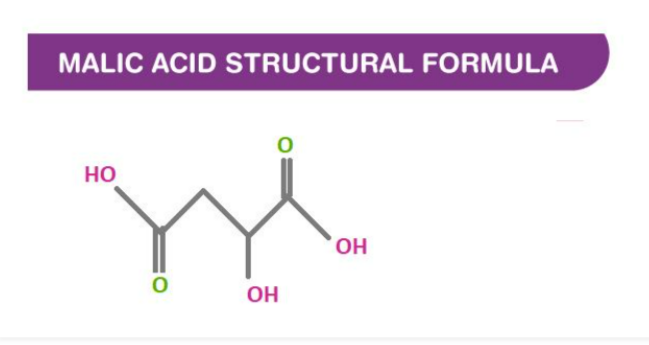
Malic acid has the molecular formula of C4H6O5 and is a dicarboxylic acid. The salts of malic acid are known as malates. It is commonly used as a food additive due to this property. Living organisms naturally produce it and also used as a food additive to contribute a sour taste to fruits. This dicarboxylic acid comes in two stereoisomeric forms (L- and D-enantiomers) but only the L-isomer is found in nature. The salts and esters of this acid are known as malates, which form an intermediate stage in the citric acid cycle. The term 'malic' originated from Latin word 'malum' which translates to 'apple' - referencing the Malus family that includes apples and crabapples.
Also Read : Cobalt Nitrate FormulaMalic Acid Structural Formula
A malic acid structural formula is: This structure shows the arrangement of atoms in malic acid, with carboxylic acid groups (-COOH) at each end and hydroxyl groups (-OH) at the second carbon atom. Malic acid is commonly used as a food additive, a natural organic acid found in various fruits.
This structure shows the arrangement of atoms in malic acid, with carboxylic acid groups (-COOH) at each end and hydroxyl groups (-OH) at the second carbon atom. Malic acid is commonly used as a food additive, a natural organic acid found in various fruits.
Malic Acid Malate Biochemistry
Malic Acid (also known as Malate) plays a pivotal role in biochemistry. In the C4 carbon fixation process, it is a source of CO2 in the Calvin cycle. It is also produced from fumarate by adding an -OH group to its si face, acting as an intermediate in the citric acid cycle. Another route of production is through pyruvate's anaplerotic reaction. Moreover, carboxylation of phosphoenolpyruvate produces Malate in plant leaves, acting as an accompanying double anion for potassium cations during solute uptake into guard cells. The result is a reduction of solute potential, facilitating water intake and leading to stomata aperture.Also Check - Discovery of Proton Formula
Synthesis of Malate and Malic Acid
As a result of double-hydrating maleic anhydride in the industrial environment, racemic malic acid is produced. In 2000, the United States produced 5000 tonnes of malic acid annually. Fermentation of fumaric acid yields the (S)-enantiomer, and chiral resolution of the racemic mixture yields both enantiomers. Malic acid self-condenses with fuming sulfuric acid to form pyrone coumaric acid.Malic Acid Purpose
Energy Enhancer The human body develops malic acid, which is an essential component of the Krebs. Eating malic acid helps synthesize carbohydrates, proteins, and fatty acids to cycle generate adenosine triphosphate, or simply ATP, which is part of this cycle. All living organisms on the planet rely on this complex organic chemical for cellular energy.Also Check - Molar Volume formula
Used as a supplement to treat Fibromyalgia and Chronic Fatigue Syndrome. A combination of magnesium and malic acid can be used to treat fibromyalgia, but further research is needed. Supplementation with magnesium malate has been linked to reducing fibromyalgia symptoms. In some cases, magnesium malate is also used to treat chronic fatigue syndrome. Extreme fatigue is the most common symptom of chronic fatigue syndrome, whereas fibromyalgia is also characterized by exhaustion. Encourages Better Fitness Efficiency Malic acid is often mixed with creatine, a common supplement used to increase athletic efficiency for people trying to gain lean muscle mass. Helps With Common Skin Issues (like Wrinkles and Breakouts) Malic acid is frequently included in skincare products, as it has the potential to address a variety of skin concerns, including fine lines and wrinkles, hyperpigmentation, acne, and large pores. It boasts antioxidant and exfoliation properties which can be achieved by either natural or synthetic means. Due to its ability to encourage cellular turnover, malic acid is an ideal skin refiner. Moreover, its aptitude for shedding dead cells may also provide anti-aging effects as the process slows with age. Malic acid is often paired with glycolic and lactic acids for additional benefits.Malic Acid Uses
Food Industry- Malic acid is commonly used as an acidulant to provide a tart or sour flavor in sour candies, fruit-flavored beverages, and some dairy products.
- In fruit juices, fruit-flavored snacks, and carbonated beverages, it enhances the natural fruit flavor.
- The pH of foods and beverages can be adjusted with malic acid, ensuring they remain stable and safe to consume.
- It is sometimes included in dietary supplements because of its potential health benefits, including energy production and muscle function support.
- Some pharmaceuticals and active ingredients are synthesized using malic acid as a precursor.
Malic Acid Formula FAQs
What is malic acid, and where is it found naturally?
Is malic acid safe to consume in food and beverages?
What role does malic acid play in muscle function?
Can malic acid be used for cleaning purposes?
How does malic acid contribute to the sour taste in foods and drinks?










